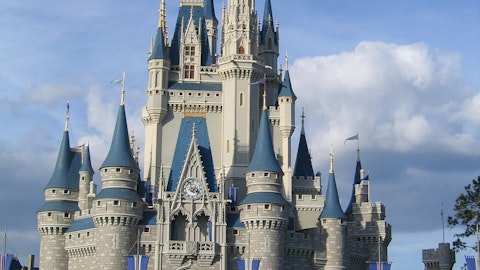Walt Disney Co (NYSE:DIS) is the type of business we like to own in our Top 20 Dividend Stocks portfolio. The company has some of the highest scores for Dividend Safety (96) and Dividend Growth (99) in our entire database, and we think Disney’s future is bright.

Despite its portfolio of extremely well-known consumer brands and hard-to-replicate assets, the stock has traded down from $120 per share in late 2015 to roughly $95 per share today.
Among the hedge funds and other investors tracked by Insider Monkey, Disney is fairly popular and during the fourth quarter of 2015, the number of funds bullish on the stock went up to 50 from 48, while the aggregate value of their holdings soared to $3.71 billion from $3.37 billion. Among these funds, Ken Fisher’s Fisher Asset Management owns 8.62 million shares, while Alex Snow’s Lansdowne Partners holds 8.24 million shares, according to their latest 13F filings.
Is it time to buy some shares, or is more downside likely ahead? Let’s take a closer look at the business.
Business Overview
Disney was founded in 1923 and has grown into a diversified worldwide entertainment company with a number of cable TV networks (e.g. ESPN, The Disney Channel, ABC Family), amusement parks and resorts (e.g. Disneyworld), motion pictures (e.g. Star Wars), and consumer products. Just over half of Disney’s total profits were generated from its Media Networks segment in 2015, with another 21% from Parks and Resorts, 13% from Studio Entertainment, and 12% from Consumer Products.
Business Analysis
Disney is arguably the most effective storyteller in the world. Humans love stories and have been telling them for literally thousands of years. As an article in The Atlantic notes, “Humans are inclined to see narratives where there are none because it can afford meaning to our lives, a form of existential problem-solving.”
Not surprisingly, forming a business around this existential human need has worked out very well for Disney over the years – the company is one of the most iconic consumer brands and was named the world’s 13th most valuable brand in 2015. Star Wars, Snow White, Mickey Mouse, Cinderella, Thor, and Frozen are just a few of Disney’s well-loved storytelling assets.
The crux of the company’s success lies in its ability to consistently identify and create high quality branded content. The company has demonstrated excellent skill in developing its own content, as well as making strategic acquisitions, which include Pixar (2006), Marvel (2009), and Lucasfilm (2012).
Once Disney has created a new favorite character, movie, or show, it can leverage that content across almost all of its businesses and technology platforms, reinforcing their recognition with consumers and creating a long, diversified tail of income. It’s amazing to think how much money a character like Mickey Mouse is still making for Disney nearly 90 years after its initial launch despite constantly evolving consumer tastes. Disney clearly has a knack for developing timeless content and stories that appeal to our foundational human traits.
Many of the company’s assets are also nearly impossible for competitors to replicate because of their dependence on Disney’s trademarked brands (e.g. Disneyworld). As a result, the company is able to create strong emotional attachment with consumers and command strong pricing power given its scarcity value (where else can you watch SportsCenter or visit Magic Kingdom?).
With an ability to develop memorable content for practically any demographic, geographic region, and technology medium, Disney has a long runway for growth.
Disney’s Key Risks
Like most consumer-focused businesses, Disney must deal with consumer tastes that are constantly evolving. As a content company, Disney needs to produce relevant programs that consumers want. Given the company’s track record for producing timeless brands, we are less concerned with this risk.
The greater concern investors have with the stock is how changes in content consumption could impact the profitability of Disney’s media networks, which generate roughly half of the company’s total profits and include crown jewel ESPN.
It’s no secret that consumers have an ever-increasing number of choices when it comes to consuming content. We can now watch TV on our iPads, rent movies online, and even cut our cable cords altogether and use cheaper alternatives like Netflix and Hulu.
The risk is that traditional pay TV packages, which bundle ESPN and other Disney networks together with other channels, move to more of an a la carte system. Many TV watchers have to pay for ESPN as part of their current bill (ESPN costs roughly $8 per month) regardless of whether or not they like sports, so the fear is that Disney could see some of its easy profits disappear depending on how the cable landscape evolves.





